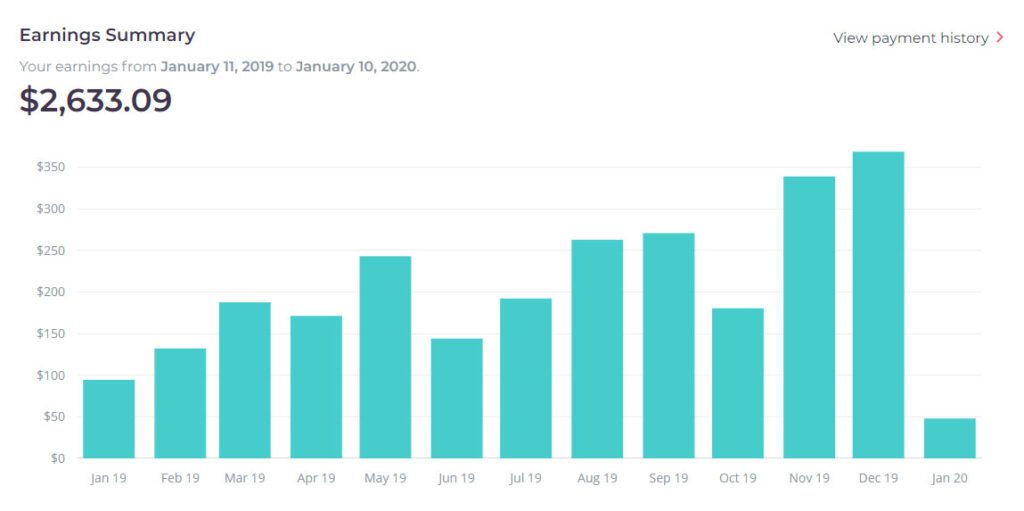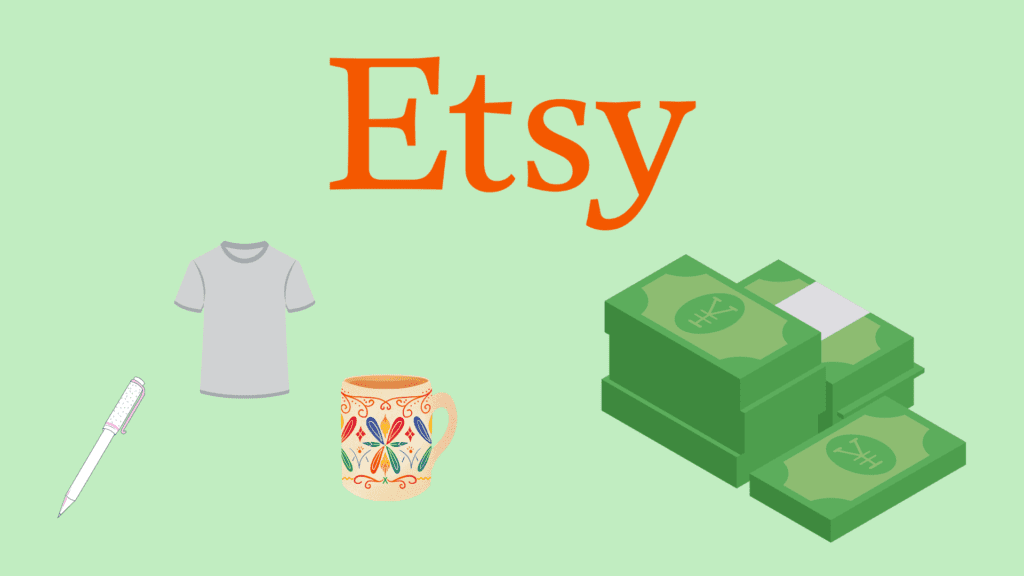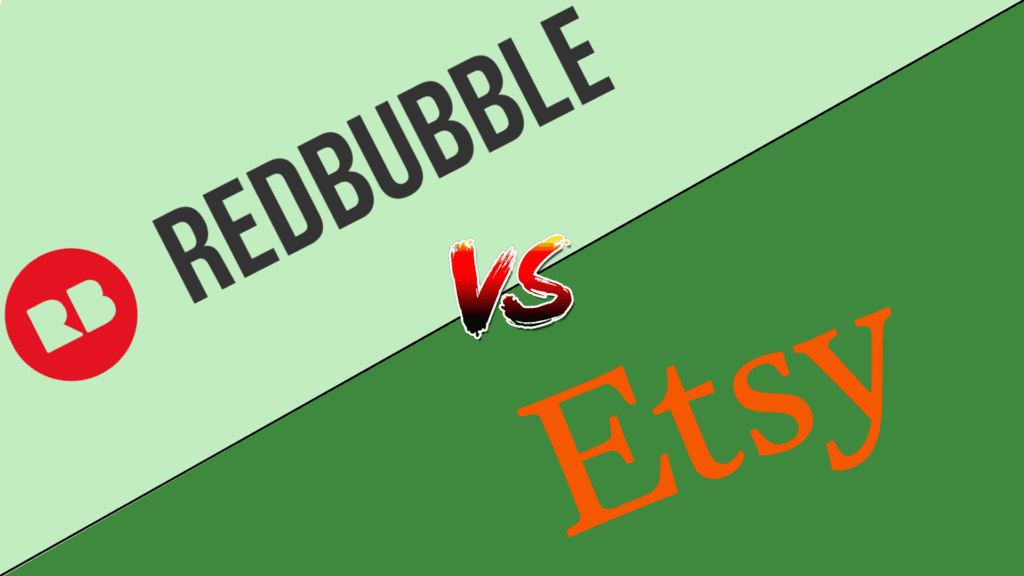Print-on-demand (POD) has become a popular way for artists and designers to sell their work without having to worry about maintaining inventory or dealing with shipping logistics. One of the biggest debates is where to sell your products, today I will get into Redbubble vs Etsy for selling Print On-Demand products.
POD is one of my favorite “passive” income methods, as almost all of the work is front loaded, and then your products just sit on many of these sites and can make sales for years to come.
Is it better to sell on Redbubble or Etsy?
The better platform depends on exactly what you are looking for as a seller. Redbubble is completely free with no barrier to entry, leading to extremely high competition, and relatively low commissions. On the other side Etsy costs money up front and you need to handle all of your own customer service, but you stand to make larger profits. Both platforms require you to do your keyword research and choose keyword-rich titles and tags in order to generate consistent sales.
Let’s get into each option a bit deeper below.
Selling on Redbubble

Redbubble is an online marketplace that allows users to upload their designs and sell them on a variety of products, such as clothing, phone cases, and home decor.
Given that Redbubble handles the production and shipping of the products, you as a creator do not need to worry about these aspects of the business.
It is 100% free to create an account and upload unlimited designs. Each design can also be placed on dozens of different products, leading to the possibility of having a catalog of thousands of products in just a few days of steady uploading.

While this does make it incredibly easy to get started and get products live and ready to sell, it also brings in heaps of competition. The saturation on Redbubble is substantial and there are thousands of talented designers.
Don’t let this discourage you though, if you do proper keyword research, and make good looking designs you can and will make sales.
That being said, Redbubble has the lowest barrier to entry, and a great option for those who want to focus solely on creating and designing, without worrying about the logistics of fulfilling orders.
With the “set it and forget it approach” you can front load all of your work and just let your designs sit on the marketplace forever and pick up sales here and there.
Additionally, Redbubble has a huge audience, which means that your products do have a good chance of being seen by potential customers even with the stiff competition.
Earnings Potential on Redbubble

As discussed above, I think you can make sales on Redbubble, will it be thousands a month? Probably not, but hundreds? Sure, that is absolutely achievable.
When it comes to competition, Redbubble tends to have more sellers with a huge variety of designs, which means that it may be more challenging to stand out and make sales.
My best-selling item on Redbubble was one of my first designs and I still make sales every week from this design almost 2 years later.
For context here is my first Redbubble accounts sales dashboard. This is over 2 years, in which I uploaded about 32 designs on the first couple of days and did absolutely nothing with the account since.

All in all, the earnings potential selling on Redbubble can definitely reach substantial amounts, but it will take substantial work, optimized keyword research, and great designs.
Selling on Etsy

Etsy differentiates from Redbubble mainly because it is an e-commerce platform. Etsy caters to a wide range of products, including physical handmade products, downloadable digital products, and Print On-Demand items.
The competition on Etsy is high, but not to the caliber of Redbubble competition, partly thanks to its 20-cent listing fee, there are fewer sellers overall than on other platforms.
And because many shops are selling handmade and vintage items, print-on-demand sellers have less direct competition in terms of product offerings.
If you want to succeed in this business model, you’ll need to do keyword research and find a niche. Handing customer service, yourself also means that you’re open to requests for custom designs, allowing you to charge extra for them.
Unlike Redbubble, Etsy allows creators to have more control over the production and shipping of their products, which can be beneficial for those who want to offer more customization options or have more control over the quality of the products they sell.
This does mean that more work will be involved on your end as you will have to outsource your POD supplier and link it to your Etsy shop.
When it comes to selecting a supplier– we recommend Printful or Printify for their great selection and quality products– buyers will need to pay for sales up front. As such, it’s wise for sellers to have a credit card ready while waiting for funds from Etsy entering their account each month.
Additionally, Etsy has a more established reputation as a marketplace for handmade and vintage items, which can attract a more niche audience for certain types of POD products.
Earnings Potential on Etsy

As discussed above, the earnings potential selling on Etsy has essentially no ceiling. With bigger reward comes bigger risk. Starting an Etsy print on-demand business, should be treated as just that, a business.
Selling print on-demand products on Etsy comes with several benefits, one of the most attractive of which is higher profit margins. Compared to Redbubble’s 25 cents to $15 per sale, Etsy sellers can potentially make anywhere from $3 to $40 depending on the prices they set– a much more lucrative option!
You will have costs associated with your Etsy shop, so do not be careless when uploading your designs.
While Etsy has a smaller audience base, it also has less competition, which can be beneficial for some sellers.
Selling on Redbubble and Etsy: Policies and Fees
It’s also important to note that both Redbubble and Etsy have their own policies and fees.
For example, Redbubble takes a percentage of the sale as commission, as well as charges a transaction fee.
Etsy also takes a percentage of the sale as commission and also charges a listing fee and a payment processing fee.
Knowing and understanding these fees is crucial to make sure that they align with your business goals and plans, so make sure to read and understand the policies and fees of each platform before you make a decision.
Print On-Demand Battle: Redbubble Vs Etsy

Both Redbubble and Etsy have their own unique advantages and disadvantages. Redbubble is a great option for those who want to focus solely on creating and designing without worrying about logistics, while Etsy offers more control over production and shipping and a more niche audience.
Carefully considering your business needs and goals will help you make the right decision when it comes to which platform to use.
Selling print-on-demand items on Redbubble or Etsy can be a great way to turn your artistic talents into a business, but it’s important to consider the pros and cons of each platform before you make a decision.
I have written many articles about print on-demand, and while I do recommend doing research, the best thing you can do is start designing quality products and get them out for sale!
Goodluck with your online money-making journey, I am rooting for you!








